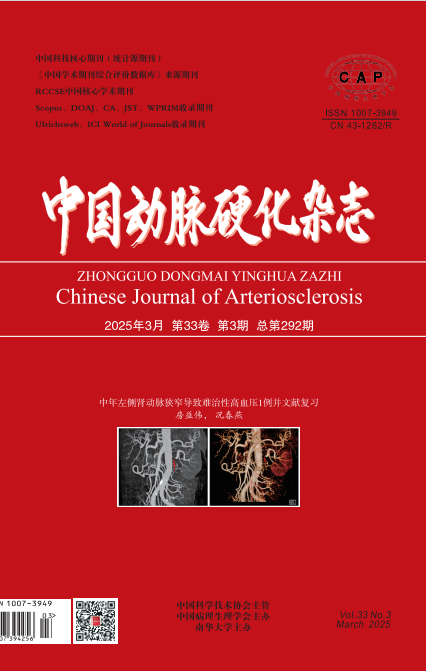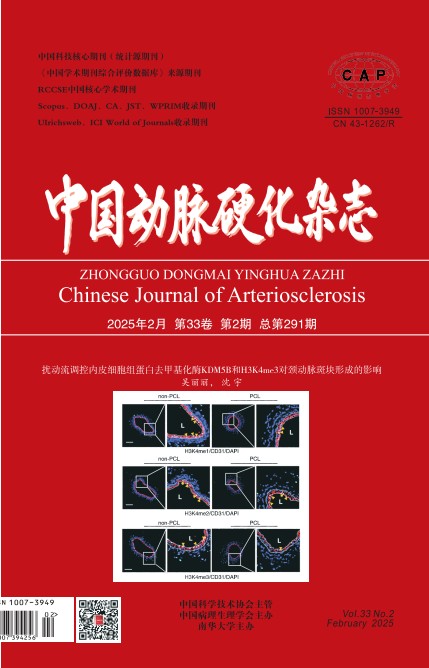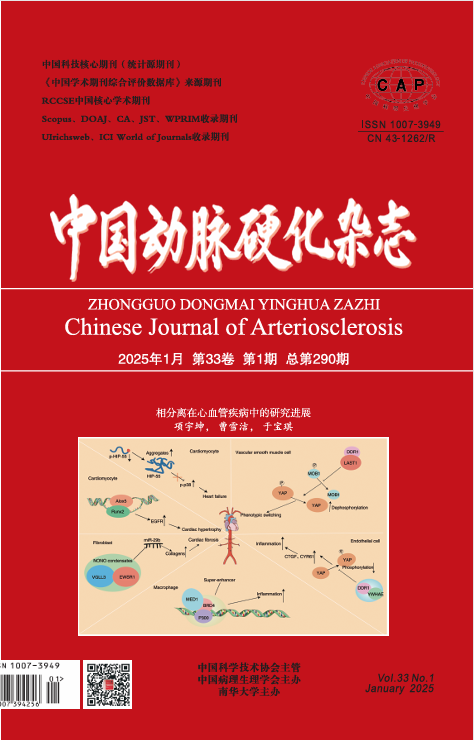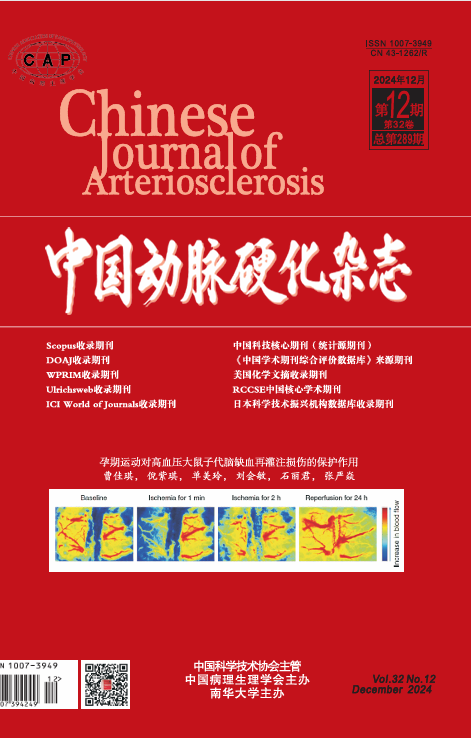 Download Center More+
Download Center More+
 Information
Information
Governing Body China Association for Science and Technology
Sponsors Chinese Association of Pathophysiology; University of South China
Editing and Publishing Editorial Office of Chinese Journal of Arteriosclerosis
Post Issuing Code 42-165
Domestic Distribution Hunan Provincial Newspaper and Periodical Distribution Bureau of China Post Group Corporation
Foreign Distribution China International Book Trading Corporation
Chinese Journal of Arteriosclerosis (CN 43-1262/R, ISSN 1007-3949) is a professional academic journal governed by China Association for Science and Technology and sponsored by Chinese Association of Pathophysiology and University of South China. The publishing scope of the journal includes the prevention and treatment of arteriosclerotic diseases (such as hyperlipidemia, coronary artery disease, ischemic cerebrovascular disease, hypertension, arteriosclerosis and other ischemic diseases) in traditional Chinese medicine, preventive medicine, basic medicine, clinical medicine, pharmacology and special medicine. The columns include original research article (including epidemiological research, experimental research, clinical research and methodological research), review, diagnosis and treatment experience, case report, lectures, etc.
See the fullprofile>
-
The progress of the role and mechanisms of circadian rhythm and clock gene in the development of atherosclerosis
LI Wenlin, LI Sainan, YANG Yao, MA Qinan, HUANG Xiuqing, DOU Lin, LIU Deping, LI Jian, SHEN Tao
2025, DOI:
Abstract:
With the extension of the global population's lifespan and the increasingly severe aging problem, cardiovascular diseases have become the leading cause of death among the elderly population. Most cardiovascular diseases originate from the formation of atherosclerotic plaques. In addition to common risk factors such as dyslipidemia, diabetes, hypertension, smoking, and obesity, circadian rhythm disruption is also regarded as an important but often overlooked risk factor for atherosclerosis. The circadian rhythm is involved in regulating key physiological processes such as inflammation and metabolism, which in turn affect the pathological processes of arteriosclerosis and thrombosis. In this process, the key genes that maintain the stability of the circadian rhythm, namely clock gene, play a crucial role. Clock gene have an important role in the pathological mechanism of atherosclerosis, and they may become potential new targets for the prevention and treatment of atherosclerosis. This paper reviews the latest research progress on the mechanism of action of clock gene in the occurrence and development of atherosclerosis. These findings may provide new ideas for the diagnosis and treatment of atherosclerosis.
-
The research advances of transcription factor EB in the regulation of lipid metabolism
LI Huijuan, WANG Yun, KUANG Tongdong, LYU Yuncheng
2025, DOI:
Abstract:
Transcription factor EB (TFEB), which belongs to the microphthalmia/transcription factor E (MiTF/TFE) family, is mainly functioned as regulator involved in regulating lysosomal function and autophagy. It plays an important role in lipid metabolism via modulating lysosomal lipid degradation, mitochondrial β-oxidation of fatty acid, and intracellular cholesterol efflux. TFEB inhibits the development of metabolic associated fatty liver disease (MAFLD) and obesity by regulating the autophagy and the expression of lipid metabolism-related genes. Additionally, it prevents the formation of foam cell from macrophages and vascular smooth muscle cells by restraining lipid accumulation, thereby attenuating the progression of atherosclerosis. TFEB promotes lipophagy to relieve lipid accumulation and lipid accumulation-induced insulin resistance, and β-cell failure, deferring diabetes-related lipid metabolic disorders. In summary, TFEB plays a key role in lipid metabolism and associated lipid disorder diseases, and serves as a potential clinical target to correct lipid dysmetabolism in vivo.
-
Angiotensin Ⅱ activates p53/SAT1 signaling pathway to induce ferroptosis in white adipocytes
DENG Wei, LIU Xiyan, GUO Liyuan, XU Qian, ZHOU Kun, ZHAO Yuanqin, WANG Zhaoyue, LI Xiang, DENG Xinmei, QIN Xinyi, REN Zhong, JIANG Zhisheng
2025, DOI:
Abstract:
Aim To investigate the effect and mechanism of angiotensin Ⅱ (AngⅡ) on ferroptosis in white adipocytes. Methods The 3T3-L1 preadipocytes were differentiated into white adipocytes by inducer stimulation. The experiment was divided into control group, AngⅡ group, AngⅡ+ Fer-1(ferroptosis inhibitor) group and AngⅡ+ PFT-α (p53 inhibitor) group. AngⅡwas used to treat cells. RT-qPCR and Western blot were used to detect the expression levels of ferroptosis factors and adipokines. JC-1 kit was used to detect mitochondrial membrane potential (MMP) level.Iron ion kit was used to detect intracellular iron content. Glutathione (GSH) kit was used to detect GSH content. Fer-1 and AngⅡ were added to treat cells to detect the the changes of ferroptosis level. The expression of p53 and spermidine/spermine N1-acetyltransferase 1 (SAT1) protein was detected. Subsequently, PFT-α and AngⅡ were added to co-treat cells to detect the changes of p53 and SAT1 protein expression, and to observe the effect of inhibiting p53 expression on the expression levels of ferroptosis factors and adipokines. Results 3T3-L1 cells were successfully differentiated into white adipocytes by stimulator-induced differentiation. AngⅡ induced ferroptosis in white adipocytes. RT-qPCR results showed that compared with control group, the mRNA expression of anti-ferroptosis factor glutathione peroxidase 4 (GPX4), solute carrier family 7 member 11 (SLC7A11) and iron regulatory protein 1 (IRP-1) was down-regulated in AngⅡ group, and the mRNA expression of pro-ferroptosis factor acyl-CoA synthetase of long-chain family member 4 (ACSL4) was up-regulated. Western blot results showed that compared with control group, the protein expression of SLC7A11 and GPX4 was down-regulated in AngⅡ group, and the protein expression of ACSL4 was up-regulated. AngⅡ treatment increased the content of intracellular iron ions and decreased the levels of GSH and MMP. Compared with AngⅡ group, the mRNA expression of IRP-1 and SLC7A11 was up-regulated in AngⅡ+Fer-1 group. AngⅡ induced changes in the expression profile of adipokines in white adipocytes. Western blot results showed that compared with control group, the protein expression of pro-inflammatory adipokine leptin (LEP), resistin (RETN), interleukin-6 (IL-6) and tumor necrosis factor-α (TNF-α) was up-regulated in AngⅡ group, and the protein expression of anti-inflammatory adipokine adiponectin (ADPN) and omentin 1 (ITLN1) was down-regulated. In addition, AngⅡ increased the protein expression of p53 and SAT1. Inhibition of p53 expression can improve the level of ferroptosis and adipokine expression in white adipocytes treated with AngⅡ. Western blot results showed that compared with AngⅡ group, the protein expression of p53 and SAT1 was down-regulated in AngⅡ + PFT-α group, the protein expression of SLC7A11 and GPX4 was up-regulated, and the protein expression of ACSL4 was down-regulated. The protein expression of ADPN was up-regulated in AngⅡ+ PFT-α group, and the protein expression of TNF-α, LEP and RETN was down-regulated. Conclusion AngⅡ induces ferroptosis in white adipocytes through activating the p53/SAT1 signaling pathway.
-
Experimental study on sleep deprivation inhibiting clock gene CRY1 expression in vascular tissue and promoting vascular senescence
NIU Jialong, WANG Furong, WANG Kexin, WANG Wenjie, LIU Yixuan, MA Xiaoyi, WANG Zhongke, GE Hailong
2025, DOI:
Abstract:
Aim To investigate the relationship between sleep deprivation and vascular aging, as well as the underlying mechanisms. Methods Male Sprague-Dawley rats were divided into control group, senescence group, sleep deprivation group, and sleep deprivation+senescence group, with 6 rats in each group. The modified level table method deprived rats of sleep duration. Senescence-associated β-galactosidase (SA-β-Gal) staining was used to detect the senescence status of rat vascular tissue. The mRNA and protein expression of tumor suppressor protein p53, silent information regulator 1 (SIRT1) and clock gene cryptochrome 1 (CRY1) was detected by real-time fluorescence quantification PCR (RT-qPCR), Western blot and immunohistochemistry. Results Compared with the control group, the intensity of SA-β-Gal staining was increased in the vascular tissues of the senescence group rats, the expression level of p53 was elevated , the expression level of SIRT1 was decreased. Similar changes were observed in the sleep deprivation group and the sleep deprivation+senescence group, including intensified SA-β-Gal staining, elevated p53 levels, and reduced SIRT1 levels in vascular tissues. Additionally, compared with the control group, the sleep deprivation group showed reduced CRY1 levels in vascular tissues, while only CRY1 mRNA levels were reduced in the sleep deprivation+senescence group. Furthermore, compared with the senescence group, the sleep deprivation+senescence group exhibited intensified SA-β-Gal staining, increased p53 level, decreased SIRT1 level, and reduced CRY1 mRNA level in vascular tissues. Conclusion Sleep deprivation may promote the expression of vascular aging-related factors, potentially through the inhibition of CRY1 expression in vascular tissues.
-
ApoAⅠ and AIBP inhibit P2X7R-mediated pyroptosis in macrophages through ABCA1
CHEN Mengjiao, ZHAO Zhenwang, WANG Siqi, WU Jianfeng, LIU Dan, ZOU Jin, ZHANG Min
2025, DOI:
Abstract:
Aim To explore the effects of apolipoprotein AⅠ (ApoAⅠ) and apolipoprotein AⅠ binding protein (AIBP) on THP-1-derived macrophage pyroptosis. Methods The lactate dehydrogenase (LDH) detection kit was used to evaluate cell membrane integrity, Hoechst33342/PI staining was used to observe cell membrane permeability, ELISA was used to detect the levels of inflammatory factors such as interleukin-1β (IL-1β) and interleukin-18 (IL-18), Western blot was used to detect the expression of pyroptosis-related protein nucleotide-binding domain leucine-rich repeat and pyrin domain-containing receptor 3 (NLRP3), gasdermin D (GSDMD), cleaved Caspase-1, IL-1β and IL-18. Results Oxidized low density lipoprotein (ox-LDL) upregulated the expression of NLRP3, GSDMD-N, cleaved Caspase-1, IL-1β and IL-18 in THP-1-derived macrophages in a concentration-dependent manner, and promoted the release of IL-1β, IL-18 and LDH (P<0.05 or P<0.01), indicating that ox-LDL induced pyroptosis in THP-1-derived macrophages in a concentration-dependent manner. Co-treatment of macrophages with ApoAⅠand AIBP significantly downregulated the expression of NLRP3, GSDMD-N, cleaved Caspase-1, IL-1β and IL-18, reduced the release of IL-1β, IL-18 and LDH, and inhibited ox-LDL induced pyroptosis (P<0.05 or P<0.01). After ATP-binding cassette transporter A1 (ABCA1) siRNA transfection, co-treatment with ApoAⅠ and AIBP had no significant effect on the expression of pyroptosis-related proteins and secretion of inflammatory factors (P>0.05). Co-treatment of macrophages with ApoAⅠ and AIBP significantly reduced the expression of purinergic 2X7R receptor (P2X7R) on the cell membrane, inhibited P2X7R mediated protein kinase R (PKR) phosphorylation and NLRP3 inflammasome assembly (P<0.05 or P<0.01). After P2X7R siRNA transfection, co-treatment with ApoAⅠand AIBP had no significant effect on the expression of pyroptosis-related proteins and secretion of inflammatory factors (P>0.05). Conclusion ApoAⅠ and AIBP reduce the expression of P2X7R on the cell membrane through ABCA1, inhibiting P2X7R/PKR/NLRP3 mediated macrophage pyroptosis.
-
Clinical efficacy and safety of sequential balloon pulmonary angioplasty in patients with chronic thromboembolic pulmonary hypertension
ZHENG Weifeng, WANG Hao, FAN Caifeng, XUE Guohua
2025, DOI:
Abstract:
Aim To explore the clinical efficacy of sequential balloon pulmonary angioplasty (BPA) in the treatment of patients with chronic thromboembolic pulmonary hypertension (CTEPH), and analyze the safety during the perioperative period. Methods 30 patients with CTEPH who underwent BPA treatment at Luoyang Central Hospital affiliated to Zhengzhou University from August 2018 to February 2024 were selected, 30 patients with CTEPH who chose drug treatment were set as controls, the patients' gender, age, body mass index, comorbidities, plasma N-terminal pro-brain natriuretic peptide (NT-proBNP) levels, application of pulmonary hypertension targeted drugs, 6-minute walking distance (6-MWD), WHO cardiac function classification and cardiac ultrasound pulmonary arterial pressure related data were collected. Right heart catheterization was performed to obtain pulmonary hemodynamic parameters in the BPA group.Changes in WHO cardiac function classification, 6-MWD, NT-proBNP, pulmonary vascular hemodynamic parameters and cardiac ultrasound pulmonary artery pressure data before BPA, after the final BPA and at 6-month follow-up were compared, as well as differences between the two groups. The occurrence and management results of surgical complications such as pulmonary artery injury, contrast nephropathy and reperfusion pulmonary edema were recorded. Results Compared with before BPA, after the last BPA, cardiac output (CO), cardiac index (CI), and mixed venous oxygen saturation (SvO2) increased, mean pulmonary artery pressure (mPAP) and pulmonary vascular resistance (PVR) decreased (all P<0.05), and 6-MWD, NT-proBNP, right ventricular diameter, right atrial up-down diameter, right atrial left-right diameter, left ventricular diastolic end diameter, and tricuspid regurgitation velocity all improved (all P<0.05). Compared with the control group, the surgical group showed an increase in 6-MWD, a decrease in NT-proBNP levels, a decrease in right ventricular diameter, right atrial up-down diameter and right atrial left-right diameter, an increase in left ventricular end diastolic diameter, a decrease in tricuspid regurgitation velocity and a significant improvement in WHO cardiac function classification (all P<0.05). Among 30 BPA patients, 2 patients experienced hemoptysis during surgery, 1 patient developed reperfusion pulmonary edema after surgery, and 1 patient developed contrast nephropathy. After treatment, all patients improved and were discharged. Conclusion Sequential BPA has good clinical efficacy and safety in the treatment of CTEPH patients, and is an effective technique for treating CTEPH, which is worth promoting in clinical practice.
-
Correlation between PCSK9, MIF and the degree of coronary artery stenosis in patients with coronary heart disease
AN Xin, FANG Binbin, YU Xiaolin, LIU Fen, XIE Qian, LI Xiaomei, YANG Yining
2025, DOI:
Abstract:
Aim To explore the relationship between serum levels of proprotein convertase subtilisin/kexin type 9 (PCSK9), macrophage migration inhibitory factor (MIF) and the severity of coronary artery lesions in patients with coronary heart disease (CHD). Methods A cross-sectional study was conducted involving 139 patients with CHD and 69 control subjects who underwent coronary angiography during the same period, all of whom were admitted to the People's Hospital of Xinjiang Uygur Autonomous Region from November 2023 to May 2024. Clinical data and coronary angiography results were collected, and the severity of coronary artery stenosis was quantitatively assessed using the Gensini score. Patients with the Gensini scores>0 were classified into three groups based on tertiles:the mild stenosis group (1~18 points, 54 cases), the moderate stenosis group (19~36 points, 54 cases), and the severe stenosis group (>36 points, 54 cases). Serum levels of PCSK9 and MIF were measured by ELISA kit. Results Serum levels of PCSK9 and MIF were significantly higher in the CHD group than those in the control group (P<0.05). Multivariable Logistic regression analysis revealed that high levels of serum PCSK9 and MIF were independent risk factors for CHD. Spearman correlation analysis showed that serum PCSK9 and MIF levels were positively correlated with Gensini score (rs=0.619 6 and rs=0.411 4, both P<0.001). Further subgroup analysis showed that serum total cholesterol and low density lipoprotein cholesterol levels were significantly increased in patients with high-level PCSK9,while patients with high-level MIF had higher inflammatory coefficients such as systemic inflammatory response index (SIRI) and systemic immune-inflammation index (SII) (all P<0.05). Conclusion Serum levels of PCSK9 and MIF are positively correlated with the severity of coronary artery stenosis. High levels of serum PCSK9 and MIF are independent risk factors for CHD.
-
The predictive value of stress hyperglycemia ratio on in-hospital mortality and mechanical complications in patients with acute ST-segment elevation myocardial infarction
ZHOU Shiheng, TAN Zhen, LIU Lei, TANG Kai, DENG Xuejun, LIU Yijun
2025, DOI:
Abstract:
Aim To explore the predictive value of stress hyperglycemia ratio (SHR) for in-hospital mortality and mechanical complications in patients with acute ST-segment elevation myocardial infarction (STEMI). Methods This study constituted a retrospective investigation that collected 995 patients diagnosed with acute STEMI at Suining Central Hospital from June 2019 to July 2023. Comparisons of baseline data were conducted using t-test, Mann-Whitney U test and chi-square test; Logistic regression was used to analyze the association between SHR and the risk of in-hospital mortality and mechanical complications in acute STEMI patients; Restricted cubic spline analysis based on the Logistic regression model was utilized to explore non-linear relationship between SHR and the risk of in-hospital mortality and mechanical complications; ROC curve was used to evaluate the diagnostic efficacy of SHR; Subgroup analysis was used to assess the predictive efficacy of SHR in each subgroup. Results Patients with high SHR had a significantly higher cardiovascular mortality (P=0.007). High SHR was an independent risk factor for in-hospital all-cause mortality (Model 1:OR=3.5,5%CI:1.719~5.538, P<0.001; Model 2:OR=2.8,5%CI:1.4439~5.132, P=0.002), cardiovascular mortality (Model 1:OR=3.6,5%CI:1.869~6.228, P<0.001; Model 2:OR=3.3,5%CI:1.595~5.817, P<0.001), ventricular aneurysm (Model 1:OR=3.3,5%CI:1.665~6.069, P<0.001; Model 2:OR=3.3,5%CI:1.785~8.663, P<0.001), cardiac rupture (Model 1:OR=2.1,5%CI:1.389~4.312, P=0.002; Model 2:OR=2.2,5%CI:1.214~4.274, P=0.009) and composite endpoint (Model 1:OR=3.9,5%CI:2.226~6.332, P<0.001; Model 2:OR=2.9,5%CI:1.576~5.405, P<0.001) in patients with acute STEMI. SHR was positively correlated in a linear relationship with the risk of in-hospital all-cause mortality (P for non-linearity=0.250), cardiovascular mortality (P for non-linearity=0.129), ventricular aneurysm (P for non-linearity=0.588), cardiac rupture (P for non-linearity=0.787) and composite endpoint (P for non-linearity=0.399). The SHR had excellent diagnostic efficacy for in-hospital all-cause mortality (AUC=0.694), cardiovascular mortality (AUC=0.697), ventricular aneurysm (AUC=0.706) , cardiac rupture (AUC=0.667) and composite endpoint (AUC=0.730), meanwhile SHR predicted efficacy consistently across subgroups. Conclusions High SHR is an independent risk factor for in-hospital all-cause mortality, cardiovascular mortality and cardiac mechanical complications in patients with acute STEMI. SHR holds significant predictive value for the prognosis of patients with STEMI.
-
Predictive value of serum miR-145 and miR-146a for slow flow/no reflow coronary artery after PCI in patients with acute coronary syndrome
2025, DOI:
Abstract:
Aim To explore the predictive value of serum microRNA-145 (miR-145) and miR-146a for postoperative coronary slow flow/no reflow (CSF/NRF) in patients with acute coronary syndrome (ACS) undergoing percutaneous coronary intervention (PCI). Methods From January 2020 to January 4,3 patients with ACS who admitted to Caidian District People's Hospital were gathered. They were divided into normal blood flow group (n=262) and CSF/NRF group (n=61) based on whether they experienced CSF/NRF after PCI. Relative expression of serum miR-145 and miR-146a was detected by RT-qPCR. General clinical data were collected and analyzed. Logistic regression analysis was applied to analyze the influencing factors of CSF/NRF in patients after PCI. Receiver operating characteristic (ROC) curve was plotted to analyze the predictive value of serum miR-145 and miR-146a for the occurrence of CSF/NRF in patients after PCI. Results Compared with the normal blood flow group, the relative expression level of serum miR-145 was greatly reduced in the CSF/NRF group, while patients in the CSF/NRF group had significantly higher levels of C-reactive protein (CRP) and brain natriuretic peptide (BNP), and the relative expression level of miR-146a (P<0.05). Increased levels of CRP, BNP and relative expression of miR-146a were risk factors for CSF/NRF in patients (P<0.05), while increased relative expression of miR-145 was a protective factor for CSF/NRF in patients (P<0.05). The area under the curve (AUC) of serum levels of miR-145, miR-146a, and their combination for predicting postoperative CSF/NRF in patients was 0.3,0.811, and 0.920, respectively. The combined prediction was greatly better than miR-145 (Z=2.919, P=0.004) and miR-146a (Z=3.341, P=0.001) alone prediction. Conclusion Serum miR-145, miR-146a in patients with ACS has an adjunctive predictive value for CSF/NRF occurrence after PCI.
-
Advances in the regulation of low density lipoprotein receptor by RING-E3 ubiquitin ligase
LIU Fangyuan, ZHANG Caiping, LONG Shiyin
2025, DOI:
Abstract:
The occurrence and development of atherosclerotic cardiovascular diseases is closely related to abnormally elevated plasma low density lipoprotein cholesterol (LDLC) level. Low density lipoprotein receptor (LDLR) plays a central role in the maintenance of cholesterol homeostasis by mediating the endocytotic clearance of LDLC, and the abundance of LDLR on the surface of the cell membrane is closely related to the expression level and recirculation of LDLR. Recent studies have found that RING-E3 ubiquitin ligase can regulate LDLR levels through a dual mechanism:on the one hand, it directly ubiquitinates and modifies LDLR to promote its degradation via the endosome-lysosome pathway; on the other hand, it reduces LDLR synthesis through activation of the liver X receptor (LXR) pathway or inhibition of the nuclear translocation of sterol regulatory element-binding protein (SREBP). Together, these two mechanisms lead to a decrease in cell membrane LDLR abundance, impairing cholesterol metabolic homeostasis and exacerbating LDLC accumulation. Therefore, targeted inhibition of RING-E3 ubiquitin ligase activity may be a novel strategy to regulate LDLR expression, reduce plasma LDLC levels, and combat cardiovascular disease. This article reviews the mechanism of action of RING-E3 ubiquitin ligase in regulating LDLR and its related research progress.
-
Effects of typical persistentorganic pollutants on atherosclerosis
KE Yijia, XU Rui, TAN Zhenzhen, LYU Junli, GUO Mingmei, SU Zhengyi, GUO Huicai
2025, DOI:
Abstract:
Cardiovascular disease is one of the serious health burdens in the world, and atherosclerosis is its important pathological basis. In recent years, the effect of environmental pollutants on human health has been paid more and more attention. Some new epidemiological studies and experiments have reported that environmental organic pollutants, involved in the occurrence and development of atherosclerosis, is an independent risk factor of cardiovascular diseases. Evidence shows that it is related to oxidative stress response, cell phenotype transformation, dyslipidemia, genetic changes and so on. This review summarizes available studies on the latest epidemiological studies and experiments of typical persistent organic pollutants such as polychlorinated biphenyls and per- and polyfluoroalkyl substances so as to provide references for future research.
-
Progress on novel vascular endothelial injury markers in cardiovascular diseases
2025, DOI:
Abstract:
Aim Biomarkers of vascular endothelial injury serve as crucial indicators for assessing vascular endothelial function and provide a basis for the diagnosis and treatment of cardiovascular diseases (CVD). Currently, the mechanisms and clinical significance of classical biomarkers, such as C-reactive protein and intercellular adhesion molecule, in CVD have been extensively studied. However, their limited sensitivity and specificity make it difficult to comprehensively reflect the progression of CVD. With the advancement of liquid biopsy and novel molecular biology detection technologies, emerging biomarkers of vascular endothelial injury have become a research focus. This article systematically reviews biomarkers of vascular endothelial injury, with a particular emphasis on the research progress and clinical applications of novel biomarkers in CVD.

 Online Submit
Online Submit Reviewing
Reviewing Edit
Edit Reader
Reader Quick Search
Quick Search External Links
External Links





